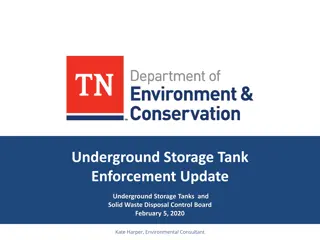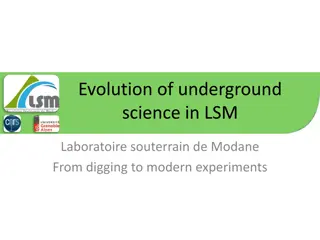Advantages and Requirements of Underground Cables
Underground cables offer advantages like better protection from damage, fewer faults, and improved appearance. However, they come with higher installation costs and insulation challenges at high voltages. Requirements include using high-conductivity stranded copper or aluminum conductors, proper insulation thickness, mechanical protection, and stable materials. Insulating materials must have properties like high resistance, dielectric strength, and mechanical durability while being non-inflammable and non-hygroscopic.
Download Presentation

Please find below an Image/Link to download the presentation.
The content on the website is provided AS IS for your information and personal use only. It may not be sold, licensed, or shared on other websites without obtaining consent from the author.If you encounter any issues during the download, it is possible that the publisher has removed the file from their server.
You are allowed to download the files provided on this website for personal or commercial use, subject to the condition that they are used lawfully. All files are the property of their respective owners.
The content on the website is provided AS IS for your information and personal use only. It may not be sold, licensed, or shared on other websites without obtaining consent from the author.
E N D
Presentation Transcript
Introduction Underground cables have several advantages such as less liable to damage through storms or lightning, less chances of faults, smaller voltage drop and better general appearance. However, their major drawback is that they have greater installation cost and introduce insulation problems at high voltages compared with the equivalent overhead system. For this reason, underground cables are employed where it is impracticable to use overhead lines. 2
An underground cable essentially consists of one or more conductors covered with suitable insulation and surrounded by a protecting cover. Several types of cables are available and the type of cable to be used will depend upon the working voltage and service requirements. They may be classified in two ways according to the type of insulating material manufacturing or/and the voltage for which they are manufactured. used in their 3
In general, an underground cable must fulfil the following necessary requirements : The conductor used should be tinned stranded copper or aluminium of high conductivity. Stranding is done so that conductor may become flexible and carry more current. 2. The conductor size should be such that the cable carries the desired load current without overheating and causes voltage drop within permissible limits. 1. 4
3. The cable must have proper thickness of insulation in order to give high degree of safety and reliability at the voltage for which it is designed. 4. The cable must be provided with suitable mechanical protection so that it may withstand the rough use in laying it. 5. The materials used in the manufacture of cables should be such that there is complete chemical and physical stability throughout. 5
Insulating Materials for Cables In general, the insulating materials used in cables should have the following properties : High insulation resistance to avoid leakage current. 2. High dielectric strength breakdown of the cable. 3. High mechanical strength to withstand the mechanical load on the cables. 4. Low cost so as to make the underground system a viable proposition. 1. to avoid electrical 6
5. Non-inflammable. 6. Non-hygroscopic i.e., it should not absorb moisture from air or soil. The moisture tends to decrease the insulation resistance and hastens the breakdown of the cable. In case the insulating material is hygroscopic, it must be enclosed in a waterproof covering like lead sheath. 7. Unaffected by acids and alkalies to avoid any chemical action. 7
The principal insulating materials used in cables are: Rubber Vulcanised India Rubber (VIR) Impregnated Paper Varnished Cambric Polyvinyl Chloride (PVC) 8
Electric Stress in a Single-Core Cable If the dielectric strength of the insulating material is exceeded during the operation of the cable, the insulation will break down. Hence, the cable must be designed so that the electric field strength, or the maximum electric stress, at the surface of the conductor does not exceed that required to break down the insulation. It has been found that the optimal ratio of the radius of the cable to the radius of the conductor is given by: ?1 ?2 = 2.718 9
Smaller ratios will result in unstable cable operation, in that the dielectric will tend to break down. Any ratio exceeding 2.718 will result in satisfactory cable operation. For economic reasons, however, it is best to maintain the ratio close to 2.718. 10
Grading of Cables In order to minimize the difference between the maximum and minimum electric field strengths in the cable, many cables contain several layers of dielectric material. This process is known as grading, and two types of grading are commonly used. (Capacitance grading and inter-sheath grading) 11
In capacitance grading two or more layers of different dielectrics are used to insulate a cable. Two such layers are shown below and the permittivities of these layers are so chosen that the maximum field strength is the same in both regions. For equal maximum field strengths, we must have: ?1?2= ?2?3 If ???? is the maximum allowable electric field strength, the operating voltage V of the cable is: ? = ???? ?3???2 ?3 + ?2???1 ?2 12
In inter-sheath grading, the cable contains several layers of a single dielectric material, separated by coaxial metallic sheaths that are inserted into the dielectric and maintained at predetermined voltages. A cable with one such inter-sheath is shown below. ?1 ?2 =?2 ?3 = ? 14
If the inter-sheath is kept at voltage ?1, then at the surface of the conductor ? ?1 =? ?1 ?3??? ?3???= ?2?3 ?3ln At the surface of the inter-sheath, the maximum electric field is ?2???= ?2ln ?1 ?1?2 ?1 = ?2??? For the maximum electric fields to be the same at these two surfaces, we must have 15
Cable Capacitance The capacitance per unit length of a single-conductor cable is given by: ? ?= ln ?2 2?? ?1 ? = in F/m In a three-conductor cable, the capacitances between pairs of conductors and between the conductors and the sheath are shown below, where equilateral spacing is assumed. To find the capacitance per phase, the delta connected capacitances are changed to their equivalent wye form. 16
Cable Inductance The inductance per unit length of a single conductor cable is given by: Analytical expressions leading to the per phase inductance of a three conductor cable are extremely cumbersome and are beyond the scope of this course. 18
Dielectric Loss and Heating In an underground cable, heat is generated through ?2? losses in the conductor and the sheath, and dielectric loss in the insulation. The dielectric loss in the insulation of the cable occurs due to leakage currents. In other words the capacitance of the cable may be considered to be lossy, having a resistance ?? as shown below. 19
The loss in ?? In terms of the loss angle ?: 20
Overhead Lines versus Underground Cables The inductance is more predominant in case of overhead lines whereas capacitance in the case of underground cables. The large charging current on very high voltage cables limits the use of cables for long length transmission. The conductor in the overhead line is less expensive than the underground cable. The size of the conductor for the same power transmission is smaller in case of overhead lines than the cables because of the better heat dissipation in overhead line. 21
The insulation cost is more in case of cables than overhead lines. The erection cost of an overhead line is much less than the underground cable. 22























